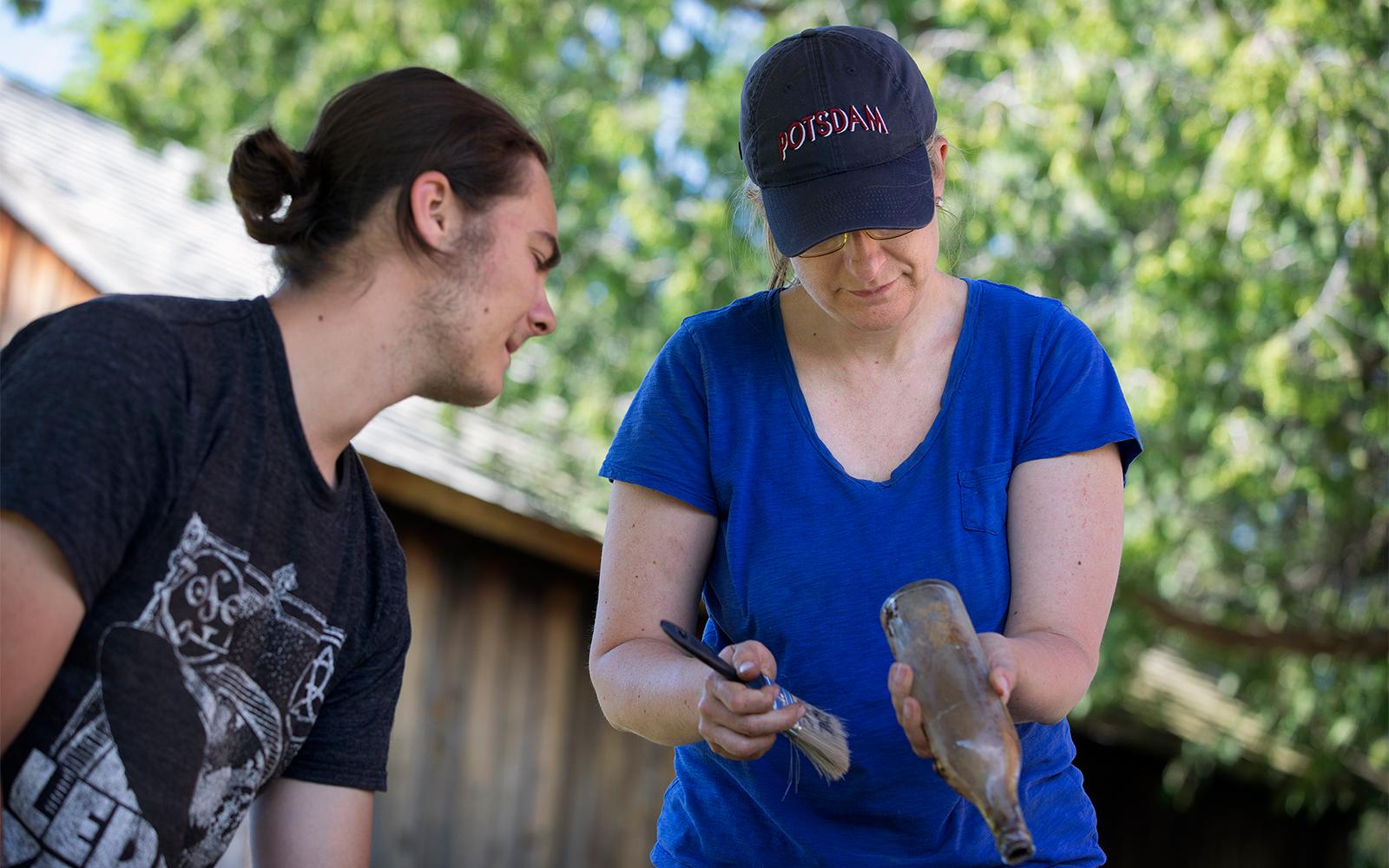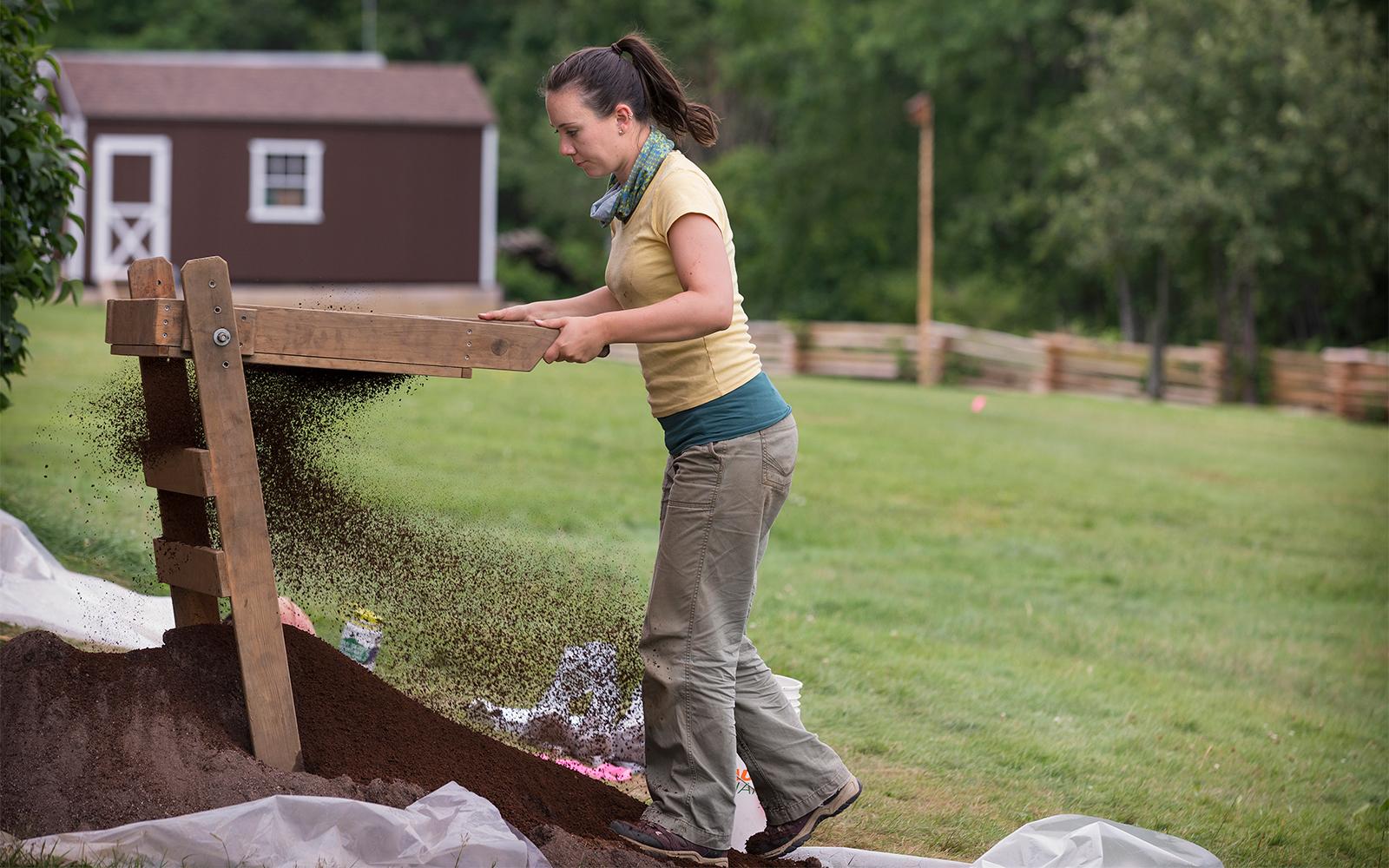In a hole, surrounded by layers of exposed soil in a 2-meter-long excavation unit, SUNY Potsdam junior Michael Madeiros ’19 uses a trowel to dig for artifacts on abolitionist John Brown’s farm. As he digs deeper and removes soil—to later be screened for artifacts—he discovers a fully intact glass bottle, just one of many items found while methodically examining the ground around John Brown’s house.
Madeiros is one of 12 SUNY Potsdam students who just finished a four-week archaeology field school at the John Brown Farm State Historic Site in Lake Placid with Dr. Hadley Kruczek-Aaron, chair for SUNY Potsdam’s Department of Anthropology. They have been employing various field techniques to find artifacts that could paint a picture of life on Brown’s farm from 1855 to 1863.
Brown moved to the Adirondacks in 1849 with his wife Mary and their children to help with the Timbuctoo settlement, a community of Black farmers who were given land by the abolitionist Gerrit Smith. In 1855, they moved to the now-historic farm, where his body was also laid to rest after his execution in 1859. “We know, from American history, a lot about John Brown. There have been many biographies written about the famous abolitionist who raided the federal arsenal at Harper’s Ferry in the fall of 1859,” said Kruczek-Aaron.
However, she said, less is known about his wife and children and everyday life on the farm.
“When I look at this house I don’t look at it as John Brown’s Farm, I look at it as Mary Brown’s Farm. That’s what we’re trying to do is reframe it and ask questions about women’s contributions to reform and activism."

To uncover clues about the past, the students started by digging shovel test pits, small circular pits that expose changes in the soil and reveal artifacts in the area, as they thought about how 19th-century people would have used the landscape. Implementing metal detector surveys and historic photographs, their research helps inform decisions about where to start their larger excavation units.
This is the fifth field school led by Kruczek-Aaron since she started at SUNY Potsdam in 2005. What makes this site so unique is that students are digging excavation units as close as nine feet from Brown’s front door. “It’s been a very convenient, easy place to do work as opposed to where we’ve worked in the past. Here we have a bathroom and running water. I always tell the students, ‘You don’t know how good you’ve got it here at this site,’” she said.
During field school, students used trowels, dust pans, root clippers, spoons and shovels to find tobacco bowl fragments, embroidery scissors, a mason jar dated 1858 and shoe soles. In one stratum (layer of soil), students discovered over 1000 glass fragments and hundreds of pieces of ceramic. “We kept digging, with each strata we got to, we took very detailed records. That’s what distinguishes us from treasure hunters and relic seekers,” said Lauryn Czyzewski ’19.
Changes to the landscape over the years have created one of the greatest challenges for the budding archaeologists. In the 1950s, the State of New York decided to make the house look like it did when John Brown’s family lived there. They removed the additions to the house and extra porches from the original structure. During that process, they also added a layer of sand to improve the slope in the backyard. “We saw this thick layer of sand fill that was trucked in after they removed the addition and then leveled the landscape so that it didn’t have a steep slope. It took us a little while to figure that out,” said alumna Lissa Herzing ’17, who was a teaching assistant at the field school.
Students found a lot of artifacts that likely belonged to the Lawrence family, caretakers of the property after Mary Brown and her children moved to California in 1863. The Browns were on the property for just eight years, whereas the Lawrence family occupied the farm from 1870 to 1910. So, in addition to having to dig deeper to get past the layer of sand from the 1950s construction work, they also had to differentiate artifacts that may have belonged to the Lawrence family from those of the Browns.

“In terms of the students getting the chance to find objects, it certainly has been a good site for that. There’s no shortage of artifacts being found,” Kruczek-Aaron said.
They also had the opportunity to work alongside Brown’s great-great-great-granddaughter, Alice Keesey Mecoy, who flew in from Texas just for the dig. With the help of SUNY Potsdam archaeology students, Mecoy used tools to excavate a hole right in front of her ancestor’s front door. “It was amazing and everyone was so kind,” Mecoy said. “I had such a great time with the students.”
During the final days of their field school, Alexandria Menteer ’18 was deep in an excavation unit as he continued to search for historic artifacts. “It was an awesome experience. I learned a lot. I would rather be out there doing the work and getting dirty, than sitting in a class reading papers about it,” she said.
With bags of artifacts in hand, carefully separated by the type of material and stratum from which they came, the students were prepared for the next step in the process—an Archaeological Lab Techniques taught by Kruczek-Aaron—where students learn how to clean, catalog, and conduct vessel reconstruction on the artifacts they discovered. “That class allows them to move from A to B," said Kruczek-Aaron. "And complete the circle and see how archaeologists do their work.”
Article and Photos by Jason Hunter
